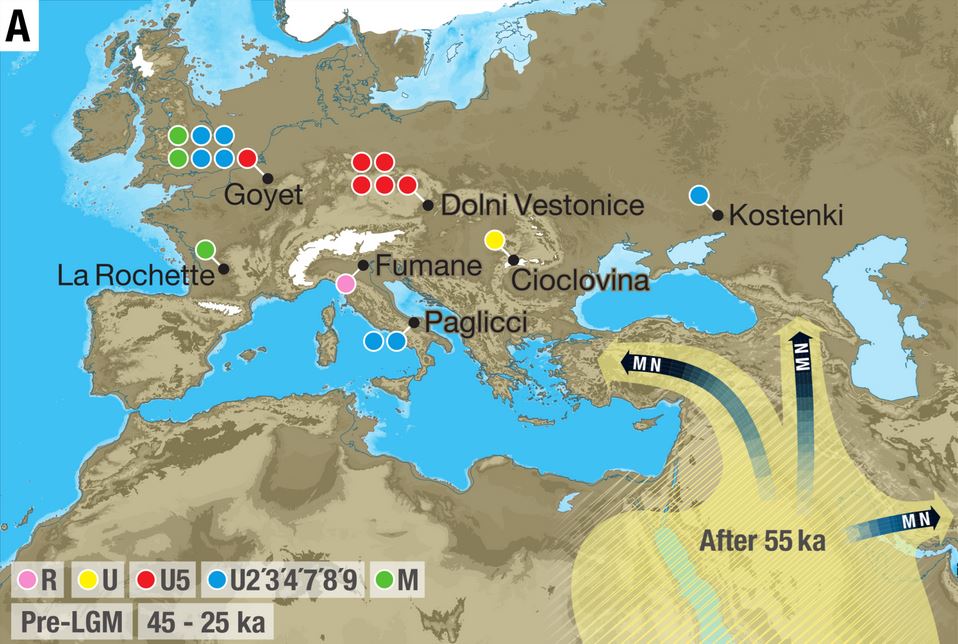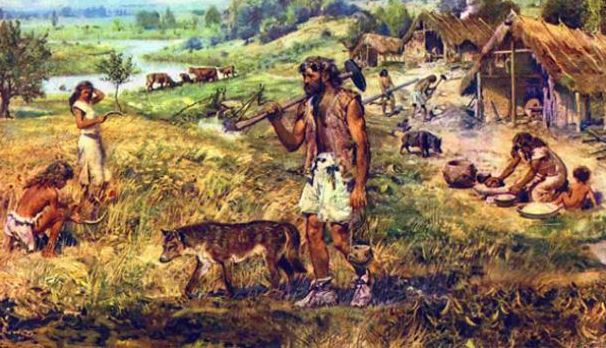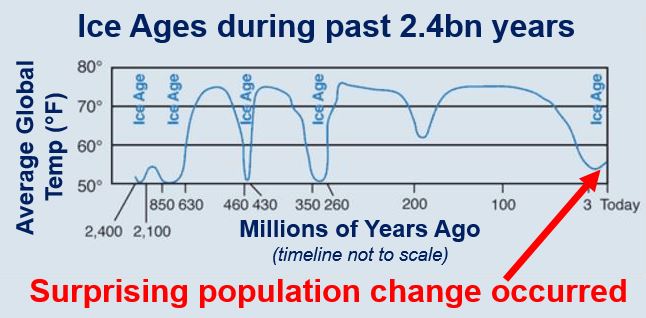A dramatic population change in Europe occurred about 15000 years ago at the end of the last Ice Age, according to DNA evidence discovered by an international team of scientists led by the Max Planck Institute for the Science of Human History in Germany.
This major and unexplained population shift occurred when local foraging (hunter-gathering) populations were nearly entirely replaced by a group from a different area, say the scientists, who had been researching our ancient ancestors’ genetics.
The researchers wrote about their study and findings in the peer-reviewed, scientific journal Current Biology (citation below).
 The study’s findings point to a single and rapid dispersal of all non-Africans populations around 50,000 years ago – not only across the Asian continent, but also into Europe. (Image: MPI for the Science of Human History. Credit: Annette Guenzel)
The study’s findings point to a single and rapid dispersal of all non-Africans populations around 50,000 years ago – not only across the Asian continent, but also into Europe. (Image: MPI for the Science of Human History. Credit: Annette Guenzel)
Genetic evidence from bones and teeth
The discovery was made after researchers carried out an extensive study of DNA evidence gathered from the teeth and bone specimens of ancient humans who lived in Europe from the Late Pleistocene to the early Holocene, a period spanning approximately 30,000 years.
Until this latest study, the dispersal of modern humans outside of Africa had been a long-debated topic, both in terms of how many major expansions there were and when they occurred.
An international team of scientists – from Germany, the USA, France, Italy, Belgium, the Netherlands, Romania, and the Czech Republic – retrieved DNA from thirty-five hunter-gatherers spanning nearly 30,000 years of European pre-history.
The findings gave them unexpected insights into early modern human population dynamics. About 50,000 years ago, there was a single and rapid dispersal of non-Africans, not only across the Asian continent, but also in Europe.
Surprising discovery of population turnover 14,500 years ago
The researchers also uncovered a previously unknown population turnover about 14,500 years ago, a time of extreme climatic instability at the end of the last Ice Age.
 A 30,000 year-old human skull, unearthed at burial 16 in the Dolní Vĕstonice archaeological site, Czech Republic. (Image: MPI for the Science of Human History. Credit: Martin Frouz)
A 30,000 year-old human skull, unearthed at burial 16 in the Dolní Vĕstonice archaeological site, Czech Republic. (Image: MPI for the Science of Human History. Credit: Martin Frouz)
Genetic data about early modern humans who existed for up to 40,000 years as hunter-gatherers in Europe is scarce, while their population dynamics and structure is virtually unknown.
Using bioinformatics and molecular techniques, scientists from the Max Planck Institute (MPI) for the Science of Human History in Jena and Tuebingen University in Germany, together with researchers from other institutions, were able to reconstruct complete mtDNA (maternally inherited mitochondrial DNA) genomes of thirty five foragers (hunter-gatherers) who lived in Germany, Belgium, Italy, Romania, France and the Czech Republic from 35,000 to 7,000 years ago.
After analyzing ancient mtDNAs, the researchers were surprised to find that three individuals from before the LGM (Last Glacial Maximum), that were unearthed in present-day France and Belgium, belong to a type of mtDNA called haplogroup M. The Last Global Maximum was the coldest period during the last Ice Age.
Scientists astonished with the result
Lead author, Cosimo Posth of Tübingen University, said:
“I couldn’t believe it. The first time I got this result I thought it must be a mistake, because in contemporary Europeans haplogroup M is effectively absent, but is found at high frequency in modern Asians, Australians and Native American populations.”
The LG started approximately 25,000 years ago. Hunter-gatherer populations retreated to several proposed *refugia in the south of Europe, experts tell us.
* Refugia are areas in which populations can survive through periods of unfavourable conditions, especially glaciation.
The researchers believe that haplogroup M could have been lost due to the smaller population size, which re-expanded later across Europe when the weather improved.
 Hunter-gatherers were humans who lived in a community where most or all of their food was obtained by picking wild plants and hunting wild animals, in contrast to agricultural societies, which relied mainly on crops and domesticated animals. (Image: geneticliteracyproject.org)
Hunter-gatherers were humans who lived in a community where most or all of their food was obtained by picking wild plants and hunting wild animals, in contrast to agricultural societies, which relied mainly on crops and domesticated animals. (Image: geneticliteracyproject.org)
Two-non African populations date back 50,000 years
The authors, who made use of ancient radiocarbon-dated mtDNA as molecular calibration points, were able to revise the mtDNA mutation rate – the rate at which DNA builds up mutation over time – and accurately dated the origin of the two non-African mtDNA types, N and M, to approximately 50,000 years ago.
Director at the MPI for the Science of Human History, Johannes Krause, said:
“This date estimate supports a late and rapid dispersal of all non-African populations carrying both M and N haplogroups, not only across Asia but also into Europe.”
 There have been several Ice Ages since the Earth was formed. The population change that surprised the scientists in this study occurred at the end of the last Ice Age. (Image adapted from kaiserscience)
There have been several Ice Ages since the Earth was formed. The population change that surprised the scientists in this study occurred at the end of the last Ice Age. (Image adapted from kaiserscience)
The new data provided even more fascinating results. While we have already known about large-scale population replacement events during the Neolithic and Bronze Age, nobody knew there had been a major shift in Europe about 14,500 years ago. The evidence from this new study showed this had occurred – at the end of the last Ice Age.
Senior author, Adam Powell, who works at the Max Planck Institute for the Science of Human History in Jena, said:
“During this period of drastic warming, it looks like the European hunter-gatherers were largely replaced by a population from a different maternal source. Our modeling of ancient European hunter-gatherers demonstrates that their *demography was likely far more complicated than previously assumed.”
* Demography is the study of human populations.
The researchers say further analyses of ancient nuclear DNA of specimens found further afield and over a wider time period, will help get a more comprehensive picture.
In an Abstract in the journal, the authors wrote:
“Demographic modeling not only indicates an LGM genetic bottleneck, but also provides surprising evidence of a major population turnover in Europe around 14,500 years ago during the Late Glacial, a period of climatic instability at the end of the Pleistocene.”
Citation: “Pleistocene Mitochondrial Genomes Suggest a Single Major Dispersal of Non-Africans and a Late Glacial Population Turnover in Europe,” Cosimo Posth, Gabriel Renaud, Adam Powell, Anja Furtwängler, Annamaria Ronchitelli, Bernard Gély, Cédric Beauval, Christoph Wißing, Christophe Cupillard, Corinne Thevenet, Damien Flas, Dan Grigourescu, David Caramelli, Dorothée G. Drucker, Elena Gigli, Frédérique Valentin, Giulia Capecchi, Hélène Rougier, Hervé Bocherens, Isabelle Crevecoeur, Jiří Svoboda, Johannes Krause, Johannes van der Plicht, Katerina Harvati, Kurt Wehrberger, Maria Malina, Martina Lari, Michael Bolus, Michael Francken, Mietje Germonpré, Nicholas J. Conard, Patrick Semal, Richard Cottiaux, Wolfgang Haak & Alissa Mittnik. Current Biology. Published: February 4, 2016. DOI: org/10.1016/j.cub.2016.01.037.
Video – From Hunter-Gatherer to Farmer
This video explains how we believe our ancient ancestors shifted from a hunter-gatherer lifestyle to a farming one. In this case, the speaker says it occured at the end (or just after) the last Ice Age.

